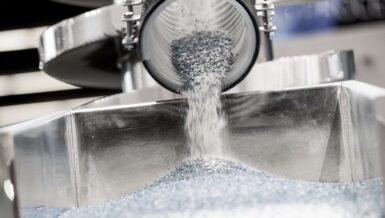That’s why the science of powder characterisation is deeply intertwined with pharmaceutical regulations, especially in Europe, where rigorous oversight ensures both product quality and patient safety.
Powder Properties as Critical Quality Attributes (CQAs)
For powder handling engineers, understanding the significance of particle-level behaviour is more than just academic. Parameters like particle size distribution, morphology, compressibility, and electrostatic charge are often considered critical quality attributes (CQAs). These attributes influence everything from how a powder blends with excipients to how it behaves during granulation, tableting, or capsule filling. In oral solid dosage forms, in particular, any deviation in particle size or flowability can affect content uniformity and dissolution profiles, leading to regulatory non-compliance or, worse, compromised therapeutic performance.
European Framework: Who Sets the Standards?
The regulatory foundation for powder characterisation in Europe rests primarily with the European Medicines Agency (EMA) and the European Commission. These institutions oversee the safety, efficacy, and quality of pharmaceutical products marketed within the European Union. A key reference document is the European Pharmacopoeia (Ph. Eur.), which outlines standardised methods for testing physical powder properties such as particle size (sieving, laser diffraction), bulk/tapped density, and angle of repose. These procedures are vital to demonstrate batch consistency and product stability.
Good Manufacturing Practice and Directive 2001/83/EC
The European regulatory architecture also draws heavily on Good Manufacturing Practice (GMP) guidelines, particularly for handling raw materials. Directive 2001/83/EC, which governs medicinal products for human use, mandates strict quality control of pharmaceutical ingredients—including excipients and APIs in powder form. According to these rules, any material that could influence the final drug product’s performance must be carefully monitored and documented.
ICH Q6A and the Role of Particle Size
The International Council for Harmonisation (ICH) guideline Q6A plays a significant role in determining when particle size becomes a regulated parameter. Specifically, if particle size affects a product’s dissolution or bioavailability, it must be included in the product specification. For drugs with narrow therapeutic windows, particle uniformity isn’t optional—it’s essential. In practice, this means that powder handling engineers must ensure robust upstream control mechanisms. The Quality by Design (QbD) framework promoted by the EMA encourages pharmaceutical manufacturers to embed quality into the product lifecycle, from initial development through to commercial production. That includes characterising powder properties early and continuously verifying them during scale-up.
National Regulatory Champions: Germany and Ireland
Within the broader EU framework, individual countries exert additional influence. Germany and Ireland stand out as pivotal players in the pharmaceutical sector. Germany is home to global giants like Bayer, Merck, and Boehringer Ingelheim. It also has strong regulatory oversight via the Federal Institute for Drugs and Medical Devices (BfArM), which ensures local compliance with EMA directives. The emphasis in Germany often leans toward extensive particle data, particularly in generics and biosimilars. In contrast, Ireland’s Health Products Regulatory Authority (HPRA) has fostered a more agile regulatory culture. Combined with tax incentives, this has made Ireland a hub for multinational pharmaceutical firms. Powder characterisation in Irish manufacturing sites must align with EU norms, but HPRA is often praised for its responsiveness and clarity in technical assessments.
Centralised Procedure and CHMP Review
At the European level, the Centralised Procedure allows pharmaceutical companies to submit a single application for marketing authorisation, valid across all EU member states. This streamlined approach is particularly common for biologics and advanced therapy medicinal products—but also applies to conventional formulations, including powders. The EMA’s Committee for Medicinal Products for Human Use (CHMP) plays a critical role in this process. It reviews data on particle morphology, flow characteristics, and polymorphic form, ensuring consistency between development and commercial batches. Any deviation, particularly in sterile or inhalable powders, could delay approval or prompt additional studies.
Annex 1: Sterile Manufacturing and Powder Contamination
The 2022 revision of Annex 1 to the GMP guidelines brought significant changes, especially for sterile manufacturing processes. For powders intended for injection or ophthalmic use, the focus is now squarely on contamination prevention. Manufacturers must implement comprehensive environmental monitoring programs and use equipment that prevents cross-contamination during filling, weighing, and transport stages. This presents unique challenges in powder handling, particularly with fine or hygroscopic materials that can easily become airborne. Containment solutions—such as split butterfly valves, isolators, or glove boxes—are becoming standard practice for high-risk powder operations.
Laboratory Testing: Compliance Through Characterisation
In practice, laboratories carry the bulk of the compliance burden. Advanced characterisation techniques are vital not only for quality assurance but also for regulatory submissions. Facilities like Delft Solids Solutions and other contract labs specialise in powder-specific analysis, offering services such as dynamic flow testing, BET surface area analysis, and electrostatic charge measurements. These capabilities help manufacturers align with both Ph. Eur. methods and EMA expectations. Innovations such as dynamic image analysis and near-infrared (NIR) spectroscopy are gaining traction due to their ability to deliver real-time data. However, current EMA guidance requires these methods to be validated against traditional techniques before they are accepted in regulatory filings.
International Trade: The Import and Export Equation
Pharmaceutical powder characterisation becomes even more complex when crossing borders. For non-EU suppliers—particularly from India and China—compliance with EU GMP is mandatory. This includes validated particle size distributions, flowability data, and even evidence of correct packaging and transportation. Increasingly, European regulators are linking powder quality to Environmental, Social, and Governance (ESG) standards. Improper handling during transit or use of non-compliant containers can jeopardise market access. On the flip side, European manufacturers exporting to regions like the United States must navigate FDA requirements, which may diverge from EMA expectations.

The U.S. Approach: FDA Expectations and Technical Rigor
In the United States, the Food and Drug Administration (FDA) enforces strict quality requirements for pharmaceutical powders. Parameters like particle size and flowability are regarded as Critical Material Attributes (CMAs) and must be incorporated into the product’s control strategy. The FDA strongly supports real-time monitoring tools, such as process analytical technology (PAT), and encourages the use of Quality by Design (QbD) principles backed by statistical modeling. Unlike some EMA guidelines, FDA filings often require more detailed justifications for analytical methods and validation strategies. For European manufacturers looking to enter the U.S. market, this means preparing for additional documentation and possibly re-validating testing methods.
Brexit and Regulatory Divergence
The United Kingdom’s departure from the EU has added further regulatory burden. UK-based manufacturers and labs must now comply with the Medicines and Healthcare products Regulatory Agency (MHRA) while also meeting EMA requirements for any products destined for the EU market. This dual compliance affects everything from powder testing documentation to validation protocols. For powder handling professionals, this means staying informed of two sets of evolving rules—a challenging feat, especially when national interpretations begin to diverge.
A Fragmented Landscape
Despite harmonisation efforts, inconsistencies across EU member states persist. Regulatory authorities in countries like Poland (URPL) or Italy (AIFA) may request additional powder characterisation data not required elsewhere. This creates uncertainty for manufacturers and delays approvals, particularly for complex generics and specialty medicines. The pharmaceutical industry continues to advocate for greater alignment, but until then, powder engineers must prepare for a patchwork of expectations.
Sustainability and the Future of Powder Processing
Sustainability is emerging as a new frontier in pharmaceutical regulation. The Pharmaceutical Strategy for Europe (2020) places emphasis on greener production methods. For powder processing, this may include the use of solvent-free granulation, recycled excipients, and energy-efficient milling techniques. While these innovations are promising, regulatory frameworks have not yet fully adapted. Without guidance on acceptable sustainability metrics, companies remain hesitant to overhaul legacy systems. Recent draft guidelines from the EMA suggest that even semi-solid dosage forms—like creams and ointments—may soon be subject to enhanced powder testing. This expanded scope further underscores the need for comprehensive powder characterisation across formulation types.
Final Reflections: Engineering for Compliance
Powder characterisation is no longer just a laboratory exercise—it’s a critical element of pharmaceutical engineering. Whether you’re designing a continuous blending line, selecting a feeder system, or validating a fluid bed dryer, your understanding of powder properties and regulatory expectations can make or break a product’s success.
With regulations in flux, geopolitical shifts like Brexit, and increasing demand for sustainable practices, powder handling engineers must remain agile. Collaboration between process engineers, QA teams, and regulatory experts has never been more essential. In this evolving landscape, staying ahead means not only mastering the science of powders—but also navigating the complex web of rules that govern their use.














